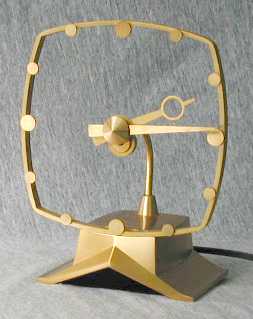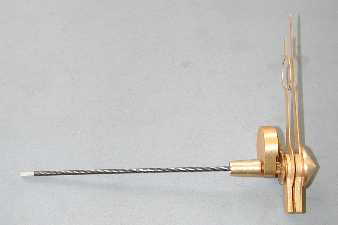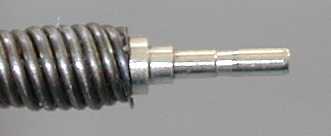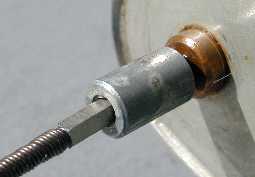Jefferson Golden Secret Repair
By Roger Russell
Copyright
1996-2004 by Roger Russell
All rights reserved
No portion of this site may be reproduced in whole or in part
without written permission of the author.
 The Golden
secret operates differently from the other clocks because it has no outer rim
gear and glass to drive the minute and hour hands. Instead, the minute hand is
driven by a motor in the base and then through a flexible cable in the curved
tube. The minute hand then drives the hour hand through a series of gears. The
counterweight provides a fixed point to make the gears turn.
The Golden
secret operates differently from the other clocks because it has no outer rim
gear and glass to drive the minute and hour hands. Instead, the minute hand is
driven by a motor in the base and then through a flexible cable in the curved
tube. The minute hand then drives the hour hand through a series of gears. The
counterweight provides a fixed point to make the gears turn.
When the clock runs slow or not at all, it could be assumed that the motor is not working or the flexible cable needs oiling or has broken from use over time. However, after examining a number of Golden Secret clocks, I have found that the motor is running and the flexible cable is in excellent condition and has no evidence of ever having been oiled or greased.
The Jefferson owners manual states: "The setting of the minute hand is made possible by an ingenious built-in friction device as used in the finest Swiss watches. "
A symptom of malfunction can be found when the minute hand doesn't slip to set the time. There should be a little resistance when moving the hand in either direction. Otherwise, it may turn part of a revolution but spring right back when you let go. That's just the flexible cable coiling or uncoiling but there's no feel of slip. Another symptom can be that the minute hand turns freely and there's no resistance at all.
 The
first step in repairing this clock is to unscrew the hand/cable assembly. I
have used a pair of gas pliers with four layers of old T-shirt around them to
unscrew the ring. It's just to the left of the counterweight in the picture. It
turns counterclockwise when viewed from the front of the clock. The cable with
the hands can then be pulled out of the tube.
The
first step in repairing this clock is to unscrew the hand/cable assembly. I
have used a pair of gas pliers with four layers of old T-shirt around them to
unscrew the ring. It's just to the left of the counterweight in the picture. It
turns counterclockwise when viewed from the front of the clock. The cable with
the hands can then be pulled out of the tube.
There appears to be no easy way to take the hand assembly apart. It may have been force fitted together at the factory. Fortunately, disassembly is not necessary in the clocks that I have seen. The secret to fixing the common problem of losing time and setting the time is to remove the cable from the ring. It doesn't come out easily. It might be necessary to put a little WD40 or Liquid Wrench at the end of the cable inside the ring to loosen it up. The cable must be removed by hand by pulling it straight out. Tools should not be used or be necessary.
 Here's
a close-up of what the end of the cable looks like after it's removed. Notice
the longer portion of the cable rod has a slight reduction in diameter near the
center. This forms a simple compression slip joint. I cleaned off the old oil.
I then put a very tiny amount of fresh oil in the hole and on the rod. Then I
reinserted the cable rod in the ring until I felt it click. The cable/hand
assembly can then be reinserted in the tube.
Here's
a close-up of what the end of the cable looks like after it's removed. Notice
the longer portion of the cable rod has a slight reduction in diameter near the
center. This forms a simple compression slip joint. I cleaned off the old oil.
I then put a very tiny amount of fresh oil in the hole and on the rod. Then I
reinserted the cable rod in the ring until I felt it click. The cable/hand
assembly can then be reinserted in the tube.
 The
other end of the cable has a square fitting that goes into the square hole in
the motor shaft. You can't see this happening, of course, because the motor
must remain in its original location in the base. When screwing the ring back
in place, rotate the minute hand back and forth at least 180 degrees to be sure
the square end of that cable will be seating in the square hole of the motor
shaft.
The
other end of the cable has a square fitting that goes into the square hole in
the motor shaft. You can't see this happening, of course, because the motor
must remain in its original location in the base. When screwing the ring back
in place, rotate the minute hand back and forth at least 180 degrees to be sure
the square end of that cable will be seating in the square hole of the motor
shaft.
The minute hand should be turned counterclockwise to set the time. A slight amount of resistance can be felt when the minute hand is turned. This is the normal cable spring. After that, the hand can be felt to slip and the time can be set. There is a small amount of springiness when doing this. After you let go, the hand should be at the time you intend to set.
The pear shaped counterweight and hour hand assembly should turn freely. If not, a very small amount of WD40 can be used to free it. Don't spray it on. Just spray a small amount on the edge of a piece of paper and insert the edge between the ring and the counterweight. That should do it.
To set the hour, turn the counterweight behind the hour hand until the hour hand is in the desired position. You will notice that the position of the hour hand relative to the counterweight changes as the hour hand advances.
Despite all of these improvements, these clocks may still leave something to be desired. Although they keep accurate time from hour to hour, the time at any particular moment may vary by a minute or two. This may be due to irregularities in the cable. Lubricating the cable seems to have no effect.
|
About This Site |
||
|
|
More text and pictures about Jefferson will be added as my research continues. Any comments, corrections, or additions are welcome. |
|
|
|
|
Created by Roger Russell |